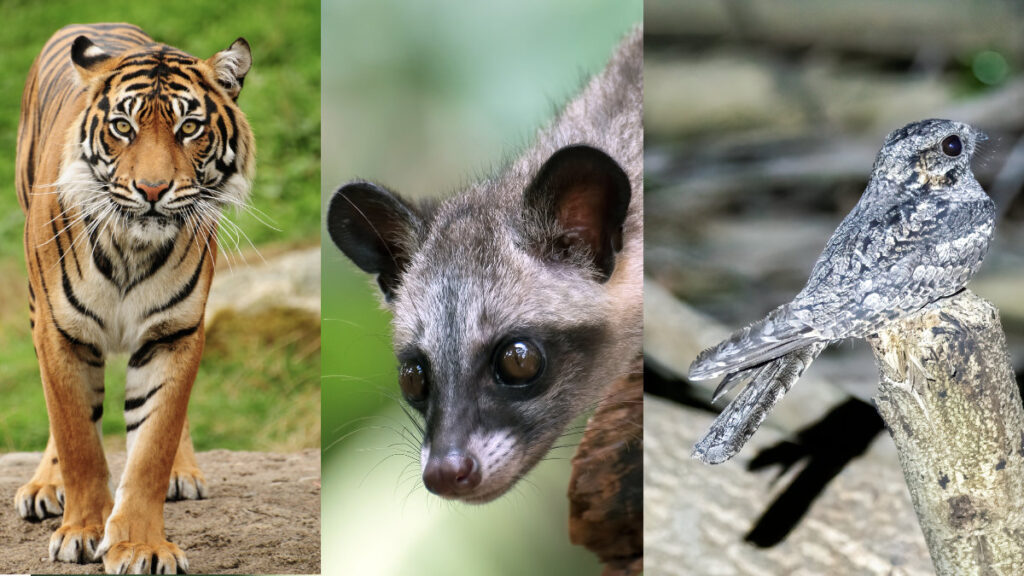Ever wondered what animals come alive after the sun sets? India’s diverse ecosystems are home to a variety of fascinating nocturnal creatures that thrive in the cover of darkness. From the stealthy Bengal tiger to the elusive Indian pangolin, let’s explore some of the incredible animals that only reveal themselves under the night sky.
Table of the Nocturnal Animals in India
Why Do Some Animals Become Nocturnal?
Nocturnal animals are adapted to be active at night to avoid predators, reduce competition for food, or to survive in environments that are too hot during the day. These animals often have enhanced senses, such as improved night vision, acute hearing, or heightened smell, that allow them to navigate and thrive in the dark.
10 Fascinating Nocturnal Animals in India
1. Bengal Tiger
The Bengal tiger is mostly nocturnal, hunting under the cover of darkness. This powerful predator prowls through the forests and grasslands of India, using its excellent night vision to ambush prey such as deer and wild boar.
- Fun Fact: Bengal tigers can see six times better in the dark than humans, giving them a significant advantage when hunting at night.
2. Indian Leopard
The Indian leopard is a versatile predator found across various habitats in India. While leopards are crepuscular (active at dawn and dusk), they often hunt during the night, especially in areas where human activity is high.
- Expert Source: According to the Wildlife Institute of India (WII), Indian leopards have adapted to nocturnal hunting to avoid human conflicts and to exploit prey availability.
3. Indian Pangolin
The Indian pangolin is a nocturnal mammal known for its unique armor-like scales. It feeds on ants and termites, using its long, sticky tongue to catch prey. Due to its secretive nocturnal habits, this species is rarely seen in the wild.
- Fun Fact: Pangolins can close their ears and nostrils to prevent ants from getting inside while feeding.
4. Slender Loris
This small, primate-like animal is native to the forests of southern India. The slender loris has large eyes that help it navigate the darkness as it hunts for insects, small mammals, and fruits.
- Fun Fact: The slender loris is known for its slow, deliberate movements, which allow it to stealthily approach prey without being detected.
5. Indian Flying Fox
The Indian flying fox is one of the largest species of bats in the world. These fruit-eating bats are entirely nocturnal, taking to the skies at night to feed on fruits, nectar, and flowers.
- Fun Fact: The wingspan of an Indian flying fox can reach up to 1.5 meters, making them impressive nocturnal fliers.
6. Rusty-Spotted Cat
The rusty-spotted cat, one of the smallest wild cats in the world, is a nocturnal hunter that stalks small prey like rodents and birds. It’s found in the forests and grasslands of India but is rarely seen due to its secretive nature.
- Expert Source: The National Centre for Biological Sciences (NCBS) states that rusty-spotted cats are highly elusive and have been challenging to study in the wild due to their nocturnal habits.
7. Indian Civet
The Indian civet is a nocturnal carnivore that roams forests and agricultural lands at night. This small, cat-like animal feeds on small mammals, birds, and insects, using its keen sense of smell to locate food in the dark.
- Fun Fact: Indian civets are known for secreting a musky scent from glands located near their tails, which was historically used in perfume making.
8. Barn Owl
The barn owl is an expert nocturnal hunter with excellent hearing and silent flight, allowing it to detect and swoop down on prey in the darkness. Barn owls are commonly found in rural areas, where they prey on rodents and small birds.
- Fun Fact: Barn owls can locate prey by sound alone, even in complete darkness.
9. Indian Crested Porcupine
Indian crested porcupines are large rodents covered in sharp quills, which they use to defend themselves from predators. They are nocturnal foragers, feeding on roots, fruits, and small plants during the night.
- Fun Fact: When threatened, porcupines rattle their quills as a warning before launching a quill attack on potential predators.
10. Indian Nightjar
Indian nightjars are nocturnal birds that are perfectly camouflaged during the day. At night, they hunt for insects, using their wide mouths to scoop up prey as they fly close to the ground.
- Expert Source: The Bombay Natural History Society (BNHS) notes that nightjars are highly adapted to nocturnal life, with excellent low-light vision and agile flight skills.
The Benefits of Nocturnal Adaptations
Nocturnal animals have evolved to take advantage of the cover of darkness, which offers protection from predators and the heat of the day. Their ability to thrive in low-light conditions is often due to specialized adaptations such as enhanced eyesight, echolocation, and acute senses of hearing and smell.
- Fun Fact: Some nocturnal animals, like owls and bats, have asymmetrical ear placement, which allows them to pinpoint the exact location of sounds, even in total darkness.
How to Spot Nocturnal Animals in India
Spotting nocturnal animals in India requires patience, knowledge, and often a guided night safari. Many national parks and wildlife sanctuaries offer night tours that provide the opportunity to see these creatures in their natural habitats. Popular parks for night safaris include Periyar Wildlife Sanctuary in Kerala, Sundarbans in West Bengal, and Satpura National Park in Madhya Pradesh.
- Expert Tip: When venturing out to spot nocturnal wildlife, bring a flashlight with a red filter. Red light is less likely to startle animals, allowing for better viewing opportunities.
Discover the Nightlife of India’s Wildlife
India’s wildlife is just as active after dark as it is during the day, with a diverse range of nocturnal creatures roaming the forests, grasslands, and rural landscapes. Whether you’re on a night safari or simply observing from a distance, the chance to witness these fascinating animals in action is truly unforgettable.

